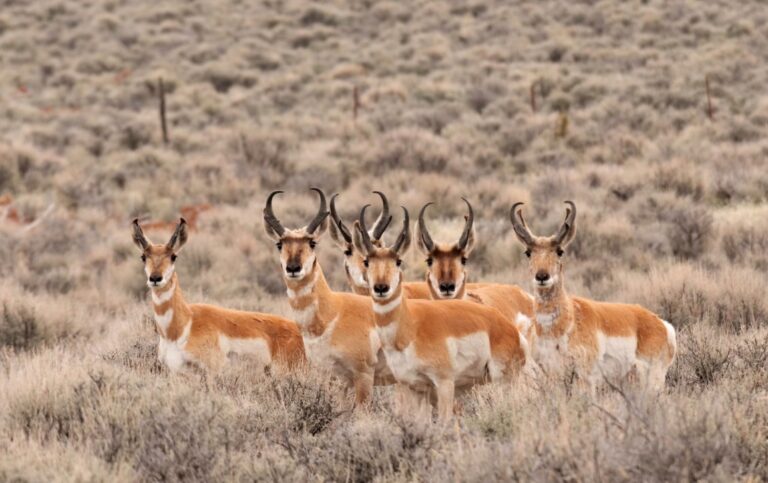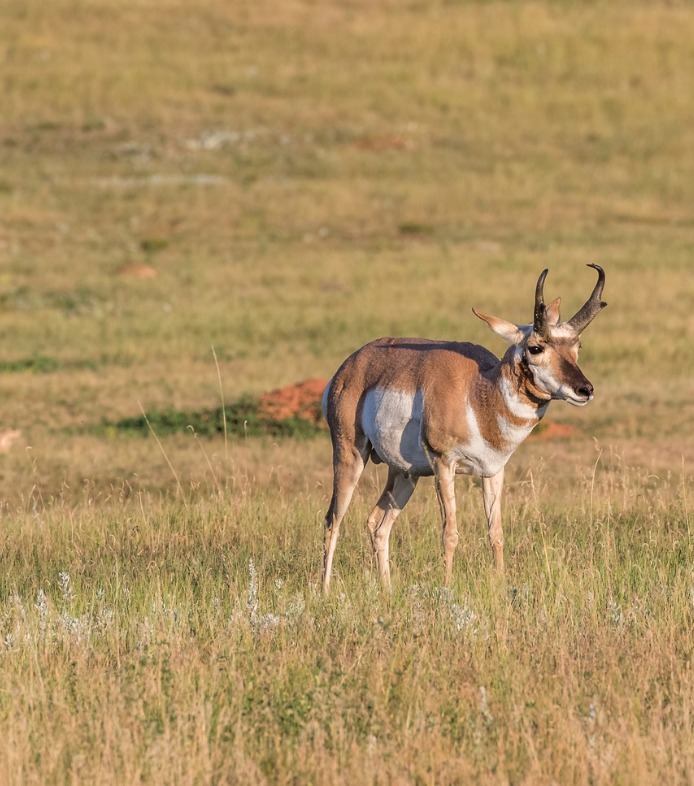Species in Peril:
Pronghorn Antelope

Antelope, Sheep or Something Else?
Pronghorn antelope, pronghorn sheep, American antelope or prongbuck, all of these names refer to the same species native to North America which is simply called Pronghorn. Although this hoofed species looks like an antelope or a goat, it’s unique enough to have its own taxonomic family, Antilocapridae. Same with its relatives, all pronghorns have a pair of horns. While the female’s horns are usually just little more than bumps, the male’s horns can reach 12 inches long. The shape of these horns are also distinctive, they point backwards and branch as its name implies. The pronghorn isn’t born with the horns or carries them all life long. Every year after the mating season, the horns would shed and regrow during the winter. Before spring, all males will have their horns ready to compete for territories. The pronghorn is not a large animal, it is usually between 2.5 to 3 feet at shoulder height. Regardless of sex, pronghorn have reddish-brown fur and striking white markings that adorn their face, neck, and stomach.. The white hairs on its rump are longer and can become visible when stuck up.
Communication is Important in a Large Group
Normally, Pronghorns live in small groups in summer, but in winter they tend to form large herds. Living with so many companions means a good communication system is super important to increase survival rate. Pronghorn depend on their strong vision a lot. With eyes as large as elephants’ eyes, they are able to detect dangers three miles away. When one pronghorn sees a predator, it will raise the white hair on its rump to alert others. Besides the visible warning, the pronghorn also releases an odor of danger from the glands on its rump. The scents they release can have more than one meaning, pronghorn use odor to mark territories and attract mates as well. Sending messages by both sights and scents allows pronghorns to avoid dangers efficiently. And as pronghorns are good runners, its amazing physical ability could also help it escape from unavoidable enemies.
Obstacles on 300-mile Migration
Few animals have been as prominent as pronghorns in the history of North America. Before the Westward Movement, there were about 100 million pronghorns living on the continent and their meat fed numerous local people. With the development of humans, the number of pronghorns is significantly decreasing but luckily, except for two subspecies, most of them are not in danger of extinction. Nowadays, the major conflicts between pronghorns and humans are the obstacles on pronghorn migration. To find a warm habitat with abundant food source, pronghorn’s round trip migration happens every winter and can cover up to 300 miles. On their way, they are not only facing predators and harsh weather, but also cars, fences, buildings and other products of modern civilization. Even though pronghorns can run fast, they are not good at jumping. Therefore, these obstacles can sometimes become impassable. To help pronghorns keep behaving naturally, more wildlife corridors should be the most feasible solution.
A Few More Facts about Pronghorn Sheep
- Pronghorns are the second fastest animals in the world, only slower than a cheetah. Their highest speed can reach 53 mph and they can retain higher speed longer than cheetahs.
- Like many hoofed animals, pronghorn digests their food twice. They don’t really need to drink because they get water from their food.
- To stay alert, pronghorns often sleep with eyes open.
- Although pronghorn can walk 30 minutes after birth, they are still vulnerable and need to live with their mother for one year.
- Peninsular pronghorn is the most endangered subspecies of pronghorn, only about 150 individuals are left.
- Scientific Species Name: Antilocapra americana
- Estimated Population: 750,000
- Conservation Status: Least Concern
- Species Range: Western and central North America
- Reason for Population Decline: Habitat loss and Fragmentation

Species Name
Acinonyx jubatus
Estimated Population
7,100 globally
Conservation Status
Vulnerable
Range
Parts of Africa; Central Iran
Reasons for Population Decline
Habitat destruction
Livestock protection
Poaching


